Paddlesports
The Freedom of Paddling
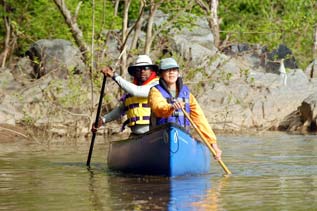
The joys of paddlesports are many. Paddling can be a hobby, an exercise activity, or a simple method from getting from one place to another. Paddlecraft come in various shapes, sizes and types. Canoes, kayaks and river rafts are the most common. Other craft such as shells, prams and other rowing devices are also gaining in popularity. Best of all, paddling provides opportunities for all skill levels from the novice to the expert, including those with disabilities.
As a paddler, you are largely responsible for your own safety. Always wear your personal flotation device (PFD) while afloat – a PFD is your single best piece of safety equipment. Also, learn basic rescue techniques so that you can help yourself and others in the event of a capsize or other emergency. And, remember that you may find yourself sharing the waters with other, often larger boats which may have difficulties spotting the smaller harder to see paddling enthusiast.
Some Statistics
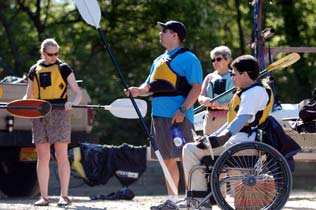
Participation in paddle sports is one of the fastest growing recreational activities in the United States with kayaking ranking as number one. With this growth, unfortunately, the number of on water accident have gone up. Sadly, most serious injuries and deaths that occur while paddling could have been prevented.
Participants must realize that paddlecraft tend to be more tippy, when compared to other water craft and thus, should minimize occupant movement to prevent capsize or falling overboard. Because canoes and kayaks are narrow, they are less stable than larger boats, so it is important to keep weight low and in the center of the craft.
Preventing an Accidental Capsizing
- Maintain at least 3 points of contact with your boat when moving around
- Load the boat properly and never exceed the boat’s capacity rating
- Keep your shoulders inside the gunwales (sides) of the boat
- Avoid poor weather, rough water and the wake of other boaters
Paddlers are also closer to the water, which makes them more susceptible to cold water temperatures in the event of a spill, so cold water deaths, especially in northern regions, are more common with paddlers. And finally, surveys indicate paddlers tend not to consider themselves boaters, and often pay little attention to learning and observing traditional boating safety rules.
Accidents Don’t Just Happen
Statistics show that over 80% of the paddlers who died in the United States were not wearing a PFD. However, 98% of paddlers report that they own one. When examining all known accident cases, including capsizes/falls overboard, it was reported that 90% of the victims go in the water unexpectedly and had no time to grab a PFD. Simply put, wearing a PFD save lives.
Hazardous water or weather conditions were cited as the primary cause in more than 40% of paddlesport accidents, pointing to the importance of consulting weather information and scouting the area first. Surprisingly, operator inexperience accounts for only one in four paddling fatalities, suggesting that the more experienced paddler often becomes complacent with safety procedures or takes unnecessary risks.
Be Safety Conscious and Know Your Limits
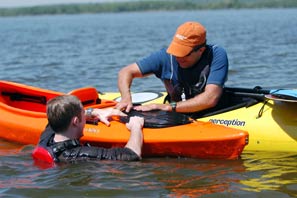
Tragically, as many of 25% of reported paddler deaths were alcohol related. Save the alcohol for when you are back ashore safely. In a paddlecraft, you need good balance and a clear head. If you are an experienced paddler, think about these statistics and lead by example. Unfortunately, the statistics have one thing in common – they’re all things that a smart paddler can plan for and, in most cases, avoid.
Be Safety Conscious and Know Your Limits
Participating in paddlesports offers something for everyone. Choosing your craft wisely, planning your outing and preparing for the inevitable will provide for maximum enjoyment whether you are participating for exercise, excitement, or a relaxation. As you go paddling, there are a number of things you need to take into consideration. The following will help you to have a safe and enjoyable time on the water.
- Take a Lesson & Get Started
- Learn Safety & Rescue Procedures
- Wear Proper Gear & Protection
- Know the Rules & Regulations
- Practice Good Environmental Ethics
- Advanced Technique
Be Safety Conscious and Know Your Limits
Taking a Class – Taking a class is a great way to get an introduction to the sport. A class will not only teach you the basics of boat handling, safety, and technique, it will also expose you to some of the widely available types of paddlecraft. Contact the American Canoe Association by calling (800) 929-5162 for a class near you.
Selecting a Boat – Paddlecraft come in all sorts of shapes and sizes – some can be paddled solo, while others are meant for tandem paddlers. Shape and size determines speed, comfort, stability, maneuverability and overall safety. Ideally, the safest boat is one that remains afloat, even when fully swamped.
Know Rules and Regs – In some states, you must register you paddlecraft and some states require that you have certain equipment aboard. Regulations can vary so check with your state boating organization. Also, since you are not the only type of water craft out there, it is important that you know basic navigation rules and can recognize aids to navigation, especially white and red informational or regulatory markers that indicate known dangers.
Be Prepared – Always be informed about the weather and the body of water in which you are boating. Be prepared to deal with weather changes, other boat traffic, low light conditions, minor medical emergencies and always have a way to contact help.
Help Yourself – Before heading out, know your own limits, practice self rescue techniques, and always travel with a group - never travel alone. However, a good rule is to assume that no one else will be there to help. Always wear your PFD.
Have Fun – When learning, always start close to shore, boat in shallow water and learn and go with a group. Never boat alone and expect to get wet. It’s inevitable that you’ll capsize at some point in your learning career – plus, its part of the fun. If you are prepared for that dunking, it won’t startle you as much.
Safety & Rescue Procedures
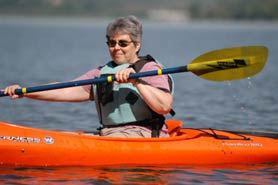
Paddling is fun, especially when it is safe. Like any outdoor activity, if you follow a few common sense rules, learn the basics of having a safe time, and are prepared physically and mentally, you’ll be able to handle the variety of experiences that paddling and the great outdoors will throw at you.
Wearing a properly fitting life jacket just makes good sense. Gone are the days of bulky life jackets. Today’s jackets are made to fit without impeding the typical movements of a paddler. They come in a variety of styles for both men and women. Many come with gussets, breathing vents and additional pockets for maximum comfort and utility. Check out the latest Type III and Type V PFD’s below.
If you are wearing your PFD, you will always know where it is. Wearing a PFD makes self rescue and assisting others easier. Basic self rescue involves righting your craft, emptying it of water, and reentering. This is easiest done when close to shore. Self rescue in deep water involves more advanced skills.
If paddling alone, which we never recommend, ask yourself if you could swim the rapids (if in white water) or, can you swim ashore while towing your boat (if near coastal). This is important if you find yourself in a situation where you are unable to get assistance or self rescue.
Go paddling in groups! It is more fun and definitely safer. Always position your strongest paddlers at the front (lead) and one at the back (sweep). Use river signals if you are not within ear shot to notify others of potential hazards. Do not take risks and avoid unnecessary hazards.
Safe Paddling Practices
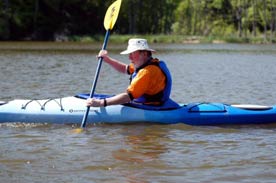
- Always wear a properly fitting PFD (lifejacket) while afloat
- Do not stand up in a canoe or kayak – keep your weight low
- Be able to handle your boat – know how to propel, steer and stop
- Dress appropriate for weather conditions – pack spare dry clothes
- Carry a supply of water and food adequate for your trip length
- Never overload the boat with more weight than it was designed
- Never boat while under the influence of alcohol or drugs
- Avoid weather and water conditions beyond your skill level
- Never approach a low-head dam, fallen tree or other obstruction
- Do not paddle alone and always inform others of your trip
- Learn about your route in advance, especially potential hazards
- Learn how to self rescue and the skills necessary to assist others
Hazards to Avoid
Fast Moving Water and High Water - Moving water has literally tons of pressure behind it. Water levels and conditions can change rapidly, especially downstream of a dam. Getting trapped in moving water or pinned to an obstruction can be deadly.
Low-Head Dams and Waterfalls - From upstream, dams look innocent enough, but don’t underestimate the power of its suction or current.
Low-head dams are especially deceiving, and in fact can be virtually invisible until you are too close to reroute.
Below dams and waterfalls, undertows and back currents (called hydraulics) can pull a paddler and his craft underwater, and sometimes pin them below the water’s surface indefinitely.
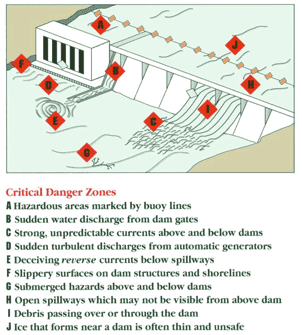
Water Obstructions and Strainers - Avoid overhanging branches or downed trees, especially in moving water. These obstacles permit water to pass through while retaining solid objects. In moving water, these obstructions can trap boats or paddlers who have fallen overboard.
Limited Visibility - Don’t count on your eyes to spot dangers at night. And in fog, don’t expect other craft to see you, especially larger fast moving boats. When approaching a blind bend in fast moving water, get out and check it out. When in doubt, scout.
Cold Water - Be especially prepared for cold water. When the air temperature and water temperature add up to 120 degrees Fahrenheit or less, wear a wet suit or a dry suit. Always carry a spare change of dry clothes in a watertight bag when boating in cold water. Falls overboard in cold water (or even exposure to cold air for a period of time) can lead to a deadly consequence called hypothermia. The most typical symptoms of hypothermia in general order of onset that you must assess and treat.
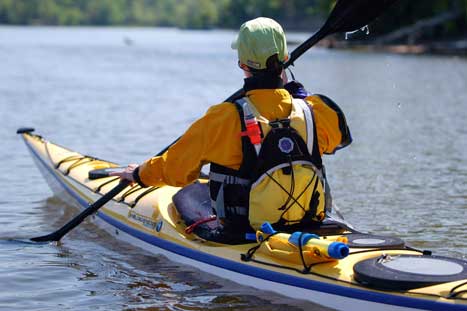
- Shivering
- Impaired judgment
- Clumsiness
- Loss of dexterity
- Slurred speech
- Inward behavior
- Shivering stops
- Muscle rigidity
- Unconsciousness
- Death
Proper Gear & Protection
Many of the annual paddling fatalities and serious injuries in the U.S. involve paddlers who are ill equipped for the conditions. Standard equipment for every participant is a properly fitting life jacket (Personal Flotation Device or PFD). Some states have made this law for persons under a certain age.
Proper clothing, including adequate foot wear, should be worn while paddling. Proper clothing will help regulate body temperature, protect you from exposure to the elements, and add an extra layer to help prevent blisters, abrasion and sunburn. As an outdoor enthusiast, you may own much of this equipment, so don’t be scared off by the huge laundry list.
However, the most important and basic rule of paddling is to wear a life jacket.
Essential Clothing & Equipment
- PFD – Properly Fitting Flotation Device
- Sun hat or helmet for whitewater
- Sunglasses with U.V. eye protection
- Sunscreen (apply frequently when wet)
- Footwear with good traction
- Dry bag with change of clothes
- Bailer, sponge or bilge pump
- Drinking water in plastic bottles or thermos
- Temperature appropriate clothing in layers
- Synthetic clothes that dry rapidly
- Dry/Wetsuit if air and water temperatures combined total less than 120 degrees
- Whistle, river knife, light, first aid kit
- Throw rope and tow line
- Map or chart and compass
Other Safety Equipment
- Spare PFD and spare paddle
- Energy bars or candy
- Signal mirror and waterproof matches
- Duct tape, small repair kit
- VHS Radio and GPS locator
Rules and Regulations
PFD Requirement - U.S. Coast Guard regulations require that canoes and kayaks of any length have a properly fitting PFD (Type I, II, III or V in flotation rating) for each person on board. In order for the Type V to qualify as required safety equipment, it must be worn. However, we strongly encourage every paddling participant to wear their PFD, at all times, regardless of type. Some states do require an additional Type IV throwable device. However, it does NOT replace the requirement for another Type PFD to meet the minimum federal carriage requirement. Regardless, it is always a good idea to have a throwable device onboard.
Registration Requirement - Only a handful of states require paddlecraft be registered with the state agency. The following states require an official registration and/or validation stickers be affixed to the craft: AK, IL, OH, OK, IA, MN and PA. Some states require that the owner’s name and address be permanently affixed to the craft in a noticeable location. These requirements allow state agencies to identify owners in the case of abandonment, separation, or theft.
Auxiliary Power - If you affix a mechanical motor for propulsion of any type, your craft becomes a “motor boat” and vessel registration is mandatory in all 50 states. You must also comply with all legal requirements designated by the Coast Guard for craft of your length. You must also abide by additional state and local regulations that pertain to motorboats, including speed limits, navigation rules and mandatory safety equipment.
Restricted Areas - All paddlers must be mindful of federally mandated exclusion and security zones and keep a safe distance of 100 yards from all Navy vessels. On local lakes and rivers, you may encounter restricted areas around bridge abutments, large dams and some shore based facilities like power plants. Of course, obey all No Trespassing signs and warnings that rivers, lakes and other bodies of water are closed.
Rules of the Road & Ship Traffic - If paddling in areas of motorboat traffic or near shipping channels, know what the buoy markers mean, especially in busy harbors where established “lanes of travel” exist. Consult with charts or use or monitor channels 13 and 16 for communication. Remember, large boats have blind spots, can’t maneuver as well, and take a long time to stop. When possible, pass astern of larger craft and wear bright noticeable colors – don’t count on them seeing you.
Environmental Ethics
By observing the following standards of conduct, paddlers reduce the opportunity for conflicts that may result in reduced waterway access and burdensome regulations.
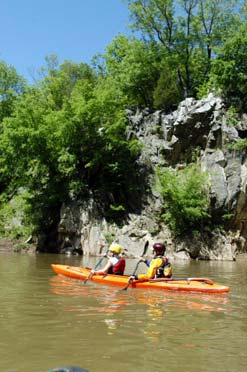
- Always pack out trash
- Recycle used fishing line
- Build fires in designated locations only
- Obey all rules and regulations
- Respect private property
- Be mindful of human waste disposal
- Use only public land and access
- Be considerate to other boaters
- Give fisherman a wide berth
- Observe wildlife at a distance
- Never change clothes in public
- Respect local culture
- Give back to the waterway
Other Safety Equipment
Safe paddling techniques and advanced rescue skills are acquired through practice. To learn properly, please consult a certified instructor or certified dealer. A life may depend on it.
Towing a Person - In flat water, you may be able to assist another person to shore by having them grab a loop or handle at the stern and tow them in. Or, you can “bulldoze” them by having them hold to the bow with their legs wrapped around the hull.
Paddle float - This device is an inflatable bag that attaches to one end of a paddle so that when the other end of the paddle is held or affixed to the boat, it provides an effective outrigger making the craft more stable and easier to enter.
Sponsons - Are cylindrical inflatable bags that can be attached to either side of a canoe or kayak to improve buoyancy and stability for re-entry.
Sling - A sling can be fashioned out of rope or webbing and can be a helpful “step” for re-boarding. Make a loop and attach it to a secure point on the boat, or loop the other end around the blade of the paddle that is help firmly in place by another person or by lashing it fast.
Swamped Boats - When a canoe or kayak fills with water, it is extremely heavy and very difficult to maneuver. Swamped boats tend to roll and bailing is often ineffective. For a swamped canoe, it is best to get the boat to shore or shallow water and emptying it. For kayaks, it is possible to drag the kayak over the deck of a fellow boater and allowing it drain. A hand operated bilge pump may assist. Whatever you do, stay with your craft, especially if you are unsure of your ability to make it ashore.
River Running - When attempting to run a river that is moving quickly, be sure you get instruction in river reading and know how to handle the river’s currents. Also, use the American Whitewater River Signal system to communicate with other members in your party when traveling in moving water and stay together as best as possible.
Moving Water Capsizes - When capsized in moving water, first check for your partner and swim to the upstream end of the craft. To avoid being pinned, do not position yourself between the boat and a rock. Leave your craft only when it will improve your personal safety. To lesson your chance of injury in fast water, position yourself on your back and point your feet downstream and at the surface of the water if you become separated from your craft. Be cautious exiting the water - do not attempt to stand in moving water above knee level. The possibility of foot entrapment is great, even in relatively slow moving water.
Throw Rope Bag - is a rescue device that can be thrown quickly to a swimmer or used to unpin a canoe. It can be easily stored and should be ready for quick use and should have at least 50’ of 3/8” brightly colored poly propylene rope (it floats).
To use a throw bag, first make sure your footing is secure. Open the bag to let the rope to freely run out, and then grasp the bag in your throwing hand. Hold the free end in your other hand and shout, “ROPE!” to the swimmer. Then throw the bag either underhand or overhand. Aim to cross the swimmer with the rope. Brace yourself for significant force when the rope becomes taut.
These skills (and more) should be learned in a class setting, taught by knowledgeable, experienced, certified instructors. Paddlers would be well served to seek out such classes and instructors and learn these skills. Your life may depend on it.
Much of the information in this section has been provided the American Canoe Association (ACA), a nationwide, not for profit organization that is in service to the broader paddling public. It is the oldest waterway-based conservation organization in the world and is dedicated to preserving the nation’s waterways, and to grow the sport of paddling by providing education on matters related to paddling, supporting stewardship of the paddling environment, and enabling programs and events to support paddlesport recreation. To learn more and join the ACA, or to take a paddlesports class, visit www.acanet.org or call (800) 929-5162.

